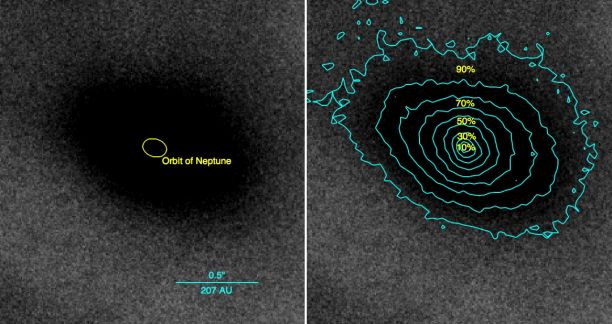New Telescope Tech Takes Sharpest Night Sky Photos Ever

Astronomers have taken the sharpest-ever photos of the night sky in visible light, with the aid of a new camera and "adaptive optics" system that cancels out the blurring effects of Earth's atmosphere.
The photographic gear, which is installed on the 21-foot (6.5 meters) Magellan telescope in Chile's Atacama Desert, captures visible-light images twice as sharp as those snapped by NASA's Hubble Space Telescope, researchers said.
"We can, for the first time, make long-exposure images that resolve objects just 0.02 arcseconds across – the equivalent of a dime viewed from more than a hundred miles away," project principal scientist Laird Close, of the University of Arizona, said in a statement. "At that resolution, you could see a baseball diamond on the moon." [Sharpest-Ever Night Sky Photos: Gallery]
Hubble had long taken the best visible-light photos, the limitations imposed by its relatively small 8-foot (2.4 m) mirror more than offset by the advantage of being above Earth's atmosphere. But the adaptive optics system developed by Close and his colleagues helped dethrone the venerable space telescope.
The team's "Magellan Adaptive Optics" system, or MagAO for short, uses a magnetic field to float a razor-thin, 2.8-foot-wide (0.9 m) mirror 30 feet (9 m) above the Magellan telescope's main mirror. This small, curved mirror can change its shape at 585 points on its surface 1,000 times every second, researchers said.
"As a result, we can see the visible sky more clearly than ever before," Close said. "It's almost like having a telescope with a 21-foot mirror in space."
Breaking space news, the latest updates on rocket launches, skywatching events and more!
Close and his colleagues report the first science discoveries from the new camera and MagAO in three papers published today (Aug. 21) in The Astrophysical Journal.
In one study, the team pointed the Magellan telescope at a famous binary star in the Orion nebula called Theta 1 Ori C. The astronomers took a photo resolving the binary into its two constituent components — something that had never been done before.
"I have been imaging Theta 1 Ori C for more than 20 years and never could directly see that it was in fact two stars," Close said. "But as soon as we turned on the MagAO system, it was beautifully split into two stars."
Another study looked at how radiation from Theta 1 Ori C affects planet-forming disks around nearby stars, while the third investigated the distribution of gas and dust around another star in the Orion nebula.
"It is important to understand how dust is laid out in these objects because that dust and gas is what nature uses to build planets," Close said. "Our new imaging capabilities revealed there is very little dust and gas in the outer part of the disk."
"This tells us something about planet-forming disks in these dense, stellar nurseries," he added. "There appears to be a limit to the formation of massive planets very far away from their parent stars. One possible explanation might be the presence of a massive star like Theta 1 Ori C stripping away the outer gas and dust."
Follow Mike Wall on Twitter @michaeldwall and Google+. Follow us @Spacedotcom, Facebook or Google+. Originally published on SPACE.com.

Michael Wall is a Senior Space Writer with Space.com and joined the team in 2010. He primarily covers exoplanets, spaceflight and military space, but has been known to dabble in the space art beat. His book about the search for alien life, "Out There," was published on Nov. 13, 2018. Before becoming a science writer, Michael worked as a herpetologist and wildlife biologist. He has a Ph.D. in evolutionary biology from the University of Sydney, Australia, a bachelor's degree from the University of Arizona, and a graduate certificate in science writing from the University of California, Santa Cruz. To find out what his latest project is, you can follow Michael on Twitter.


